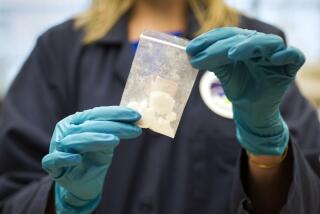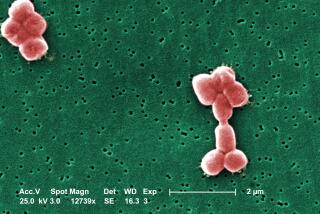‘Zombie’ drug bath salts more potent than meth, study finds
Bath salts, the synthetic drug made infamous by incidents of psychotic “zombie” attacks, is more potent and potentially addictive than methamphetamine, a study has found.
Rats pressed a lever as many as 900 times in an attempt to get a dose of the powerful stimulant, nearly four times the effort they would exert to get a similar dose of highly addictive methamphetamine, according to experiments done at the Scripps Research Institute.
“This has a lot more power than methamphetamine does to reinforce behavior,” said psychologist Michael A. Taffe, who specializes in addictive disorders at the La Jolla institute.
While on the drug, the rats exhibited obsessive behaviors, licking biting and sniffing the sides of their cages. Such “stereotypy” has been correlated with extreme behavior among humans high on stimulants. Those results, said Taffe, lend credence to media reports and law enforcement videos showing “zombie-like” behavior among users.
Symptoms of intoxication include euphoria, hyper-alertness, anxiety, agitation, psychotic behavior and hallucinations, loss of motor control, and elevated heart rates and blood pressure.
The study, published online Wednesday ahead of the August print edition of Neuropharmacology, represents the most extensive examination to date of the effects of 3,4 methylenedioxypyrovalerone, or MDPV. The drug, marketed as “bath salts” and other names, is the latest generation of designer stimulants to hit the U.S. markets.
“It’s referred to in the popular press as bath salts, but it’s a diversity of compounds and they’re all based on what’s called the cathinone core. It’s very similar to amphetamine,” said Taffe. “There are an awful lot of designer entities, designer drugs, which have been springing up in the recreational market that are based on this cathinone core. MDPV is just one of them.”
Cathinone is derived from khat, a leaf commonly chewed in areas of the Horn of Africa, notably Somalia, and in the Arabian Peninsula. Most law enforcement seizures have pointed to China as a source for the drugs designed around that core molecule, Taffe said.
After a surge in emergency room visits and arrests associated with abuse of MDPV, the federal Drug Enforcement Administration in 2011 placed MDPV and two similar synthetic cathinone compounds on its Schedule I list under the Controlled Substances Act. Many states and cities banned the sale of bath salts and similar products.
Use of the drug may be falling, however. The American Assn. of Poison Control Centers reported 6,136 calls related to bath salts in 2011, up from 304 the year before. By the end of 2012, such calls dropped to 2,656, and through the first half of this year, the centers received 528 calls.
MDPV acts on several neurotransmitters, predominantly dopamine, which is associated with reward circuitry in the brain. It also affects levels of serotonins and norepinepherine. “It’s very potent, so you would need a relatively small amount of it to have a relatively large effect as a dopamine transporter, and it is relatively selective for a dopamine transporter,” said Taffe.
Scripps researchers are trying to “stay ahead of the curve” on related drugs and eventually develop effective counter measures and vaccines, Taffe said.







